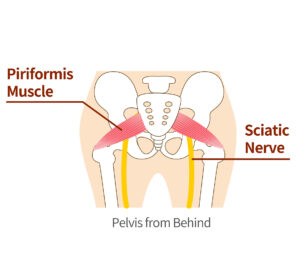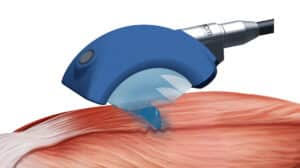🎥 Chapters
Treating Piriformis Syndrome with Shockwave Therapy
With Chiropractor in Los Gatos, San Jose, SF Bay Area, CA

Piriformis syndrome helped with Shockwave therapy
Piriformis syndrome, also known as wallet sciatica or deep gluteal syndrome, is a condition characterized by the compression or irritation of the sciatic nerve by the piriformis muscle and shockwave therapy can help. Your piriformis muscle, located in the buttocks region, plays a crucial role in hip rotation and stability. When this muscle becomes tight or inflamed, it can exert pressure on the sciatic nerve, leading to symptoms such as pain, numbness, and tingling that radiate down the back of the leg, commonly known as sciatica. ESWT, or Extracorporeal Shockwave Therapy, has emerged as a promising treatment option for piriformis syndrome and associated sciatica, offering non-invasive relief from pain and discomfort.
Piezowave Shockwave Therapy

Illustration of piriformis and sciatic nerve
In our office, we use the Piezowave. This emits low energy focused shockwaves at prescribed depths. This is unlike Radial Shockwave where the wave form is different, it is unfocused and the power diminishes as it goes deeper. We do not recommend Radial Shockwave for Piriformis Syndrome.
ESWT or Extracorporeal Shockwave Therapy can, also, be called Acoustic Wave Therapy, delivers low-energy focused shockwaves to the affected area, promoting tissue regeneration, reducing inflammation, and improving blood flow. By targeting the piriformis muscle and surrounding structures, ESWT helps release muscle tension, alleviate nerve compression, and promote healing. This results in reduced pain and improved function, allowing individuals with piriformis syndrome to experience relief from sciatic symptoms and regain mobility.
Non-Invasive ESWT Shockwave for Piriformis and Sciatic Nerve
There are several ways in which the piriformis muscle can become tight and irritate the sciatic nerve. One common cause is overuse or repetitive strain, often seen in athletes or individuals who engage in activities that involve repetitive hip movements, such as running or cycling. In addition, muscle imbalances, poor posture, and prolonged sitting can contribute to piriformis tightness and subsequent sciatic nerve irritation. Trauma or injury to the buttocks region, such as a fall or direct impact, can also lead to piriformis syndrome. Furthermore, anatomical variations, such as a narrow sciatic foramen or abnormal piriformis muscle anatomy, may increase the risk of nerve compression and piriformis syndrome development.

Shockwave Therapy
ESWT offers several advantages for the treatment of piriformis syndrome and associated sciatica. Unlike traditional surgical interventions, ESWT is non-invasive and does not require anesthesia, reducing the risk of complications and downtime for patients. Additionally, ESWT can be performed on an outpatient basis, allowing individuals to resume their daily activities shortly after treatment. This makes ESWT a convenient and accessible option for individuals seeking relief from piriformis syndrome and sciatica without the need for surgery or prolonged rehabilitation.
In conclusion, ESWT offers a safe and effective treatment option for individuals suffering from piriformis syndrome and associated sciatica. By targeting the piriformis muscle and surrounding structures, ESWT helps release muscle tension, reduce inflammation, and promote tissue healing, ultimately alleviating pain and improving function. With its non-invasive nature, convenience, and potential for lasting improvements, ESWT is a valuable addition to the treatment options available for piriformis syndrome and sciatica.
In this video, and my other shockwave videos, you will be exposed to the mechanisms of healing and to some of the latest research on shockwave and the prescribed condition. It is, truly, an amazing modality and I wouldn’t have a practice without one in my office.
Research on Piriformis Syndrome and ESWT
*Comparing radial extracorporeal shockwave therapy and corticosteroid injection in the treatment of piriformis syndrome: A randomized clinical trial
https://www.sciencedirect.com/science/article/abs/pii/S1360859222001292
*Surgical and Non-surgical Treatment Options for Piriformis Syndrome: A Literature Review https://www.ncbi.nlm.nih.gov/pmc/articles/PMC8241586/
*Focused Extracorporeal Shockwave Therapy in Physical Medicine and Rehabilitation
https://link.springer.com/article/10.1007/s40141-020-00306-z
